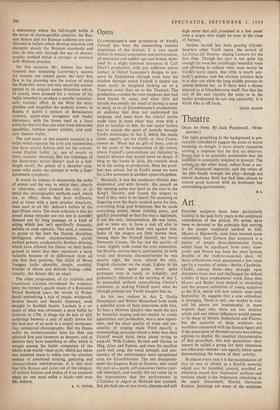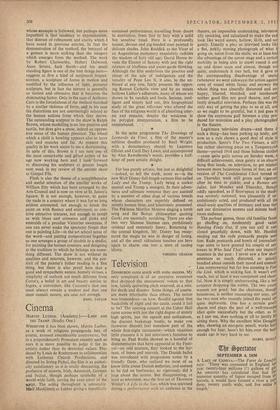Art
ENGLISH sculptors have been particularly faithful in the past forty years to the sculptural orthodoxies of the period. No artists have been so devoted to the principle that carving is the proper sculptural method as Gill, Moore or Hepworth; none have insisted more vehemently than Dobson that sculpture is a matter of simple three-dimensional forms which must be significant from every view- point; and Moore has been the most famous disciple of the truth-to-materials ideal. All three orthodoxies were questioned a few years ago by a number of artists—Butler, Chadwick, Clarke, among them—who wrought open structures from iron and challenged the defiant solidity of their predecessors' work. Since then Moore and Butler have turned to modelling and the present exhibition of young sculptors at the ICA, which will now remain open untiA September 10, suggests that a new orthodoxy is emerging. There is only one worker in wire and his pieces are insubstantial in more respects than one; there are two abstract artists and one whose influences would appear to be those of Moore, Sutherland and Picasso, but the majority of these sculptors are modellers concerned with the human figure and if the generation of devoted carvers was always anxious to display the essential characteristics of that procedure, this new generation—they cannot be called a group for their intentions are otherwise various—are equally intent upon demonstrating the nature of their activity.
In almost every case it is the manipulation of clay or wax or plaster as a flexible material which can be moulded, poured, prodded or otherwise teased into 'expressive' surfaces and textures which is the impression remaining in the mind. Giacometti, Marini, Germaine Richier, Armitage are some of the sculptors
whose.ixample-is followed, but perhaps more important-TS-that -tendency to expressionism, that distrust of refinement and clarity which I have noted in previous articles. In fact the demonstration of the method, the betrayal of a gesture is more striking than the imagery which emerges from the method. The work by Robert Clatworthy, Hubert Da!wood, Anne Severs, Jack Smith—and his small standing figure is one of the best things here— suggests at first a kind of sculptural impres- sionism, a sculpture of forms in motion and modified by the influence of light, pictorial sculpture, but in fact the texture is generally so violent and obtrusive that it becomes the dominating factor. Only in the case of Anthony Caro is the forcefulness of the method matched by a similar violence of form, and in his case the distortions are not convincingly related to the human actions from which they derive. The outstanding sculptor in the show is Ralph Brown, whose modelling is no less positive and tactile, but does give a sense, indeed an oppres- sive sense of the human presence. The wheel which a child is bowling appears also to have skin and muscles and fat. At present this quality in his work.seems to me a shortcoming. In spite of this, Brown is I am sure one of the most remarkable and gifted artists of his age now working here and I look' forward to discussing his sculpture at greater length next week in my review of the current show at Gimpel Fits.
Flesh is also the theme of a comprehensive and useful selection of the smaller works of William Etty which has been arranged by the Arts Council and is now on view at St. James's Square. It is not enough, however, to paint the nude in a country where it was for so long seldom attempted, not enough to brush the paint on with fluency and enjoyment, to con- trive attractive textures, not enough to tempt us with blues and crimsons and pinks and emeralds of a peculiar Victorian sweetness, if one can never make the spectator forget that one is painting Life—in the art school sense of the word—and putting compositions together as one arranges a group of models in a studio; for painting the human creature, and designing in the tradition to which he belongs are some- thing different. The show is not without its qualities and interests, however, and the por- trait of the painter's father reading is a fine thing, but there is also proof here that a good and sympathetic nature, homely virtues, a simplicity of outlook not much different from Corot's, a belief in art and beauty similar to Ingres, a conviction, like Cezanne's that one must always remain a student and that one must consult nature, are also not enough.
BASIL TAYLOR



































 Previous page
Previous page